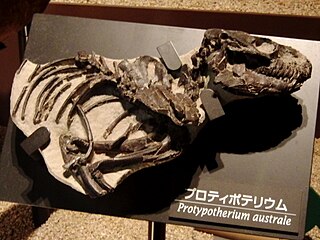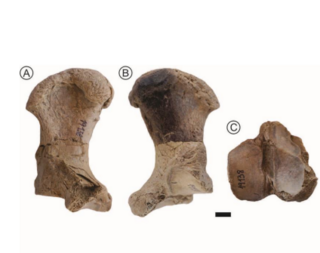See also
- Santa Cruz Mudstone, a Late Miocene geologic formation in California
- Santa Cruz Member, a member of the Late Jurassic Unidade Bombarral formation in Portugal
Santa Cruz Formation may refer to:

Channel Islands National Park consists of five of the eight Channel Islands off the Pacific coast of the U.S. state of California. Although the islands are close to the shore of the densely populated state, they have been relatively undeveloped. The park covers 249,561 acres (100,994 ha), of which 79,019 acres (31,978 ha) are federal land. The Nature Conservancy owns and manages 76% of Santa Cruz Island, the largest of the eight.
Homunculus is an extinct genus of New World monkey that lived in Argentina during the Miocene. Two species are known: Homunculus patagonicus and Homunculus vizcainoi, which are known from material found in the Santa Cruz Formation in Argentina.

Hapalops is an extinct genus of ground sloth from the Early to Late Miocene of Brazil, Bolivia, Colombia, and Argentina in South America.

Theosodon is an extinct genus of litoptern mammal from the Early to Middle Miocene of South America.

Protypotherium is an extinct genus of notoungulate mammals native to South America during the Oligocene and Miocene epochs. A number of closely related animals date back further, to the Eocene. Fossils of Protypotherium have been found in the Deseadan Fray Bentos Formation of Uruguay, Muyu Huasi and Nazareno Formations of Bolivia, Cura-Mallín and Río Frías Formations of Chile, and Santa Cruz, Salicas, Ituzaingó, Aisol, Cerro Azul, Cerro Bandera, Cerro Boleadoras, Chichinales, Sarmiento and Collón Curá Formations of Argentina.

Nesodon is a genus of Miocene mammal belonging to the extinct order Notoungulata which inhabited southern South America during the Late Oligocene to Miocene living from 29.0 to 16.3 Ma and existed for approximately 12.7 million years. It had a relatively large size, weighing up to 554 kg (1221 lbs) and reaching 1.5 m in height.

Psilopterus is an extinct genus of phorusrhacid from the Middle Oligocene to possibly the Late Pleistocene of Argentina and Uruguay. Compared to other phorusrhacids, members of the genus are both relatively gracile and diminutive, and include the smallest known species of terror bird: with the head raised P. bachmanni was 70–80 centimeters (2.3–2.6 ft) in height and weighed about 5 kilograms (11 lb), while the largest members of the genus were only about 8 kilograms (18 lb). The birds resemble the modern cariama, except with a heavier build and considerably smaller wings. The strong morphological similarity between the claws of the predatory cariama and Psilopterus, both of which are sharp, curved, and laterally compressed, may indicate they were used to strike prey. In contrast to the other, larger terror birds, Tonni and Tambussi also suggested Psilopterus could use their claws to climb trees, and could even fly, but this has been rejected in more recent literature. Fossil finds in Uruguay indicate the genus may have survived until 96,040 ± 6,300 years ago, millions of years after the larger phorusrhacids became extinct.
The Magallanes Basin or Austral Basin is a major sedimentary basin in southern Patagonia. The basin covers a surface of about 170,000 to 200,000 square kilometres and has a NNW-SSE oriented shape. The basin is bounded to the west by the Andes mountains and is separated from the Malvinas Basin to the east by the Río Chico-Dungeness High. The basin evolved from being an extensional back-arc basin in the Mesozoic to being a compressional foreland basin in the Cenozoic. Rocks within the basin are Jurassic in age and include the Cerro Toro Formation. Three ages of the SALMA classification are defined in the basin; the Early Miocene Santacrucian from the Santa Cruz Formation and Friasian from the Río Frías Formation and the Pleistocene Ensenadan from the La Ensenada Formation.
The Santacrucian age is a period of geologic time within the Early Miocene epoch of the Neogene, used more specifically with SALMA classification in South America. It follows the Colhuehuapian and precedes the Friasian age.

The Purisima Formation is a geologic formation in California. It preserves fossils dating from the Late Miocene to Late Pliocene.
The Santa Cruz Mudstone is a geologic formation in California. The siliceous organic mudstones of the formation were deposited in deep water and fluvial environments. The formation overlies the Santa Margarita Sandstone and is overlain by the Purisima Formation. The Santa Cruz Mudstone was formerly considered part of the Monterey Formation. The formation preserves bivalve and echinoid fossils as well as vertebrates of Parabalaenoptera baulinensis and Otodus megalodon. The formation dates back to the Late Miocene period.
La Cruz Formation may refer to:

Hegetotherium is an extinct genus of mammals from the Early to Middle Miocene of South America. Fossils of this genus have been found in the Cerro Bandera, Cerro Boleadoras, Chichinales, Collón Curá, Santa Cruz and Sarmiento Formations of Argentina, the Nazareno Formation of Bolivia, and the Galera and Río Frías Formations of Chile.
Santa Ana Formation may refer to:
Santa Teresa Formation may refer to:

Prepoplanops is an extinct genus of ground sloth of the family Megatheriidae. It lived in the Miocene around 18 to 16 million years ago of what is now Argentina. The only known species is Prepoplanops boleadorensis.

Paramacrauchenia is an extinct genus of proterotheriid litopterns from the Early Miocene of what is now Argentina and Chile. Its fossils have been found in the Sarmiento and Santa Cruz Formations of Argentina and Chile.
Boleatherium is an extinct genus of interatheriid notoungulate that lived from the Early to Middle Miocene of what is now Argentina. Fossils of this genus have been found in the Cerro Boleadoras Formation, the formation which this genus was named after.

Perimys is an extinct genus of neoepiblemid rodent that lived from the Early to Late Miocene in what is now South America. Fossils have been found in the Cerro Bandera, Cerro Boleadoras, Ituzaingó, Santa Cruz, and Sarmiento Formations of Argentina, and the Galera, Santa Cruz and Río Frías Formations of Chile.

The Santa Cruz Formation is a geological formation in the Magallanes/Austral Basin in southern Patagonia in Argentina and in adjacent areas of Chile. It dates to the late Early Miocene epoch, and is contemporaneous with eponymous Santacrucian SALMA. The formation extends from the Andes to the Atlantic coast. In its coastal section it is divided into two members, the lower, fossil rich Estancia La Costa Member, which has a lithology predominantly consisting of tuffaceous deposits and fine grained sedimentary claystone and mudstone, and the upper fossil-poor Estancia La Angelina Member, which consists of sedimentary rock, primarily claystone, mudstone, and sandstone. The environment of deposition is interpreted to have been mostly fluvial, with the lowermost part of the Estancia La Costa Member being transitional between fluvial and marine conditions. The environment of the Estancia La Costa Member is thought to have been relatively warm and humid, but likely became somewhat cooler and drier towards the end of the sequence. The Santa Cruz Formation is known for its abundance of South American native ungulates ,as well as an abundance of rodents, xenarthrans, and metatherians.